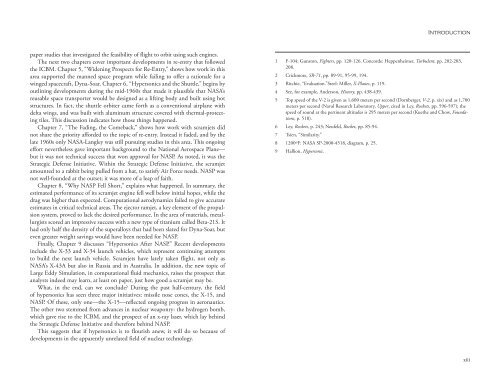Facing the Heat Barrier - NASA's History Office
Facing the Heat Barrier - NASA's History Office
Facing the Heat Barrier - NASA's History Office
Create successful ePaper yourself
Turn your PDF publications into a flip-book with our unique Google optimized e-Paper software.
paper studies that investigated <strong>the</strong> feasibility of flight to orbit using such engines.<br />
The next two chapters cover important developments in re-entry that followed<br />
<strong>the</strong> ICBM. Chapter 5, “Widening Prospects for Re-Entry,” shows how work in this<br />
area supported <strong>the</strong> manned space program while failing to offer a rationale for a<br />
winged spacecraft, Dyna-Soar. Chapter 6, “Hypersonics and <strong>the</strong> Shuttle,” begins by<br />
outlining developments during <strong>the</strong> mid-1960s that made it plausible that NASA’s<br />
reusable space transporter would be designed as a lifting body and built using hot<br />
structures. In fact, <strong>the</strong> shuttle orbiter came forth as a conventional airplane with<br />
delta wings, and was built with aluminum structure covered with <strong>the</strong>rmal-protecting<br />
tiles. This discussion indicates how those things happened.<br />
Chapter 7, “The Fading, <strong>the</strong> Comeback,” shows how work with scramjets did<br />
not share <strong>the</strong> priority afforded to <strong>the</strong> topic of re-entry. Instead it faded, and by <strong>the</strong><br />
late 1960s only NASA-Langley was still pursuing studies in this area. This ongoing<br />
effort never<strong>the</strong>less gave important background to <strong>the</strong> National Aerospace Plane—<br />
but it was not technical success that won approval for NASP. As noted, it was <strong>the</strong><br />
Strategic Defense Initiative. Within <strong>the</strong> Strategic Defense Initiative, <strong>the</strong> scramjet<br />
amounted to a rabbit being pulled from a hat, to satisfy Air Force needs. NASP was<br />
not well-founded at <strong>the</strong> outset; it was more of a leap of faith.<br />
Chapter 8, “Why NASP Fell Short,” explains what happened. In summary, <strong>the</strong><br />
estimated performance of its scramjet engine fell well below initial hopes, while <strong>the</strong><br />
drag was higher than expected. Computational aerodynamics failed to give accurate<br />
estimates in critical technical areas. The ejector ramjet, a key element of <strong>the</strong> propulsion<br />
system, proved to lack <strong>the</strong> desired performance. In <strong>the</strong> area of materials, metallurgists<br />
scored an impressive success with a new type of titanium called Beta-21S. It<br />
had only half <strong>the</strong> density of <strong>the</strong> superalloys that had been slated for Dyna-Soar, but<br />
even greater weight savings would have been needed for NASP.<br />
Finally, Chapter 9 discusses “Hypersonics After NASP.” Recent developments<br />
include <strong>the</strong> X-33 and X-34 launch vehicles, which represent continuing attempts<br />
to build <strong>the</strong> next launch vehicle. Scramjets have lately taken flight, not only as<br />
NASA’s X-43A but also in Russia and in Australia. In addition, <strong>the</strong> new topic of<br />
Large Eddy Simulation, in computational fluid mechanics, raises <strong>the</strong> prospect that<br />
analysts indeed may learn, at least on paper, just how good a scramjet may be.<br />
What, in <strong>the</strong> end, can we conclude? During <strong>the</strong> past half-century, <strong>the</strong> field<br />
of hypersonics has seen three major initiatives: missile nose cones, <strong>the</strong> X-15, and<br />
NASP. Of <strong>the</strong>se, only one—<strong>the</strong> X-15—reflected ongoing progress in aeronautics.<br />
The o<strong>the</strong>r two stemmed from advances in nuclear weaponry: <strong>the</strong> hydrogen bomb,<br />
which gave rise to <strong>the</strong> ICBM, and <strong>the</strong> prospect of an x-ray laser, which lay behind<br />
<strong>the</strong> Strategic Defense Initiative and <strong>the</strong>refore behind NASP.<br />
This suggests that if hypersonics is to flourish anew, it will do so because of<br />
developments in <strong>the</strong> apparently unrelated field of nuclear technology.<br />
Introduction<br />
1 F-104: Gunston, Fighters, pp. 120-126. Concorde: Heppenheimer, Turbulent, pp. 202-203,<br />
208.<br />
2 Crickmore, SR-71, pp. 89-91, 95-99, 194.<br />
3 Ritchie, “Evaluation.”Steel: Miller, X-Planes, p. 119.<br />
4 See, for example, Anderson, <strong>History</strong>, pp. 438-439.<br />
5 Top speed of <strong>the</strong> V-2 is given as 1,600 meters per second (Dornberger, V-2, p. xix) and as 1,700<br />
meters per second (Naval Research Laboratory, Upper, cited in Ley, Rockets, pp. 596-597); <strong>the</strong><br />
speed of sound at <strong>the</strong> pertinent altitudes is 295 meters per second (Kue<strong>the</strong> and Chow, Foundations,<br />
p. 518).<br />
6 Ley, Rockets, p. 243; Neufeld, Rocket, pp. 85-94.<br />
7 Tsien, “Similarity.”<br />
8 1200ºF: NASA SP-2000-4518, diagram, p. 25.<br />
9 Hallion, Hypersonic.<br />
xiii
















